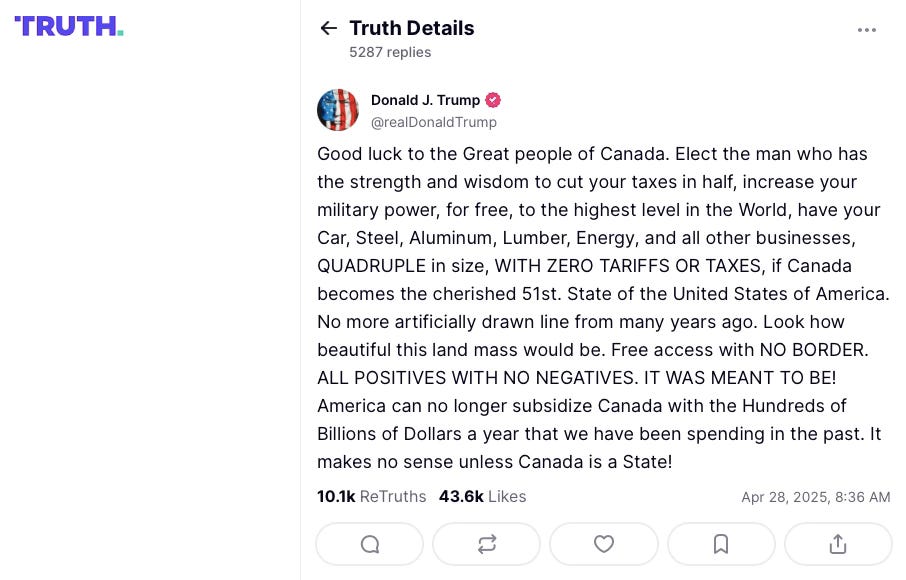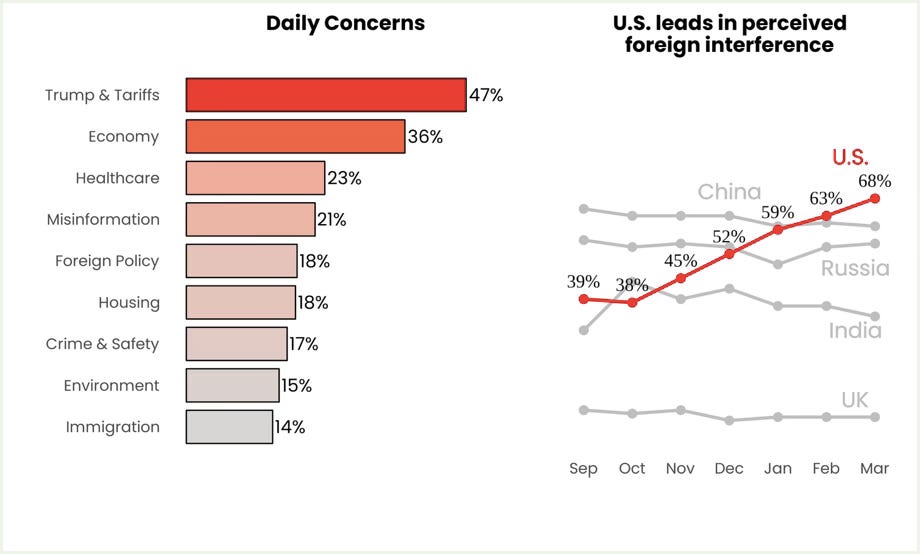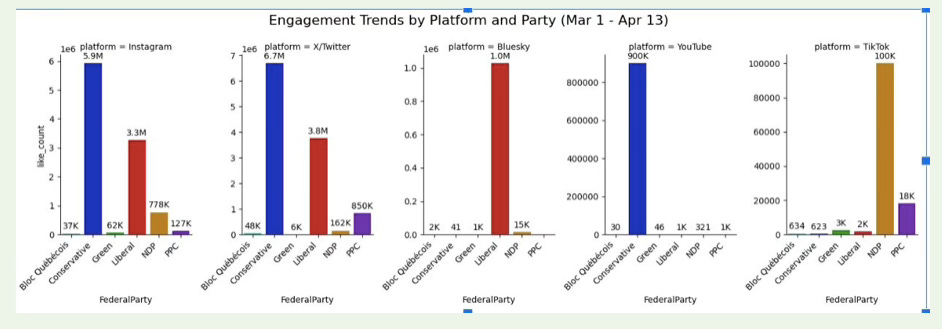Outside Influence 10
Countering State-Backed Interference
In assessing the impact of foreign-backed disinformation on Canada’s recent election campaign, the opening line of Dickens’ A Tale of Two Cities came quickly to mind: "It was the best of times, it was the worst of times (…)” Given the predicament we face, the entire first paragraph of that great novel should be mandatory reading.
Tracking outside influence on this campaign has been uplifting because so many heeded Justice Hogue’s warning that information manipulation had become “the single biggest risk to our democracy” and “an existential threat.” DisInfoWatch, the Canadian Digital Media Research Network (CDMRN) and the Security and Intelligence Threats to Elections (SITE) task force did excellent work to highlight fast-breaking issues, in real time. Just last week, the FT published the results of research that identified a large bot network targeting Carney (and mostly favourable to Poilievre); DFRLab published a study of “Bot-like activity targets Canadian political parties and their leaders ahead of election” which found that the “majority of bot-like accounts targeted the Liberal Party, followed by the Conservative Party, with proportions of about 4 to 1, respectively.” Intriguingly, several accounts highlighted in this DFRLab report have been ‘suspended for violating X rules’.
The Diehard Optimist reached different, but not incompatible conclusions. Our samples over nine updates showed the Twitter/X algorithm was boosting positive posts about Carney and the Liberal Party of Canada (LPC), while feeds mentioning Poilievre were much more negative. We also found accounts – one in particular was highlighted – that promoted Poilievre and his Conservative Party of Canada (CPC) but sought to associate them with fringe causes, including Wexit, Alberta separatism, Canada becoming a 51st state, the People’s Party of Canada (PPC), anti-vax movements, MAGA, Trump, World Economic Forum conspiracies, Hamas and Russia, among others. On election day itself, Trump posted this:
It was his third intervention in Canada’s election in only four days. Poilievre claimed Trump preferred Carney as prime minister so he could face, as Politico glossed it, “a weak Liberal government going forward.” Carney said he was the best choice to stand up to Trump and asked for a majority mandate to counter US threats. When the campaign began, the CDMRN noted that Canadians already viewed the US as the top source of foreign interference – ahead of China, Russia and India:
Trump’s final bombshells, lobbed into the campaign’s closing days, aimed to keep US-related concerns top of mind, which most analysts believe benefited Carney and the LPC. While CDMRN found that Twitter/X hosted “73% of all social media posts by federal candidates,” with CPC and PPC candidates accounting for nearly two-thirds of them, we found the Twitter/X algorithm to be robustly pro-Carney. As this comparison of engagement trends (which is also from CDMRN) shows, Twitter/X and Instagram were the only major platforms used intensively by both parties:
So how do we reconcile these varying conclusions about bots, proxies and US influence? Canada’s 2025 election campaign saw Trump, Musk, Russian active measures and Chinese proxies pulling in the same direction toward one strategic goal. China’s United Front Work Department remained focused on specific LPC nominations and candidates, as they were during Canada’s 2019 and 2021 elections. Trump’s outbursts and Musk’s Twitter/X algorithm consistently favoured the LPC, which they and Moscow see as less likely to boost military spending, increase Canadian energy exports or provide large-scale support for Ukraine. At the same time, Russia-directed bot and proxy activity on Twitter/X worked to link the CPC with Trump, MAGA, the PPC, Alberta separatism and other extreme positions as part of a longer-term strategy to co-opt the CPC, as Russia did with the GOP.
In other words, all of these players sought to re-elect the LPC and radicalize the CPC.
How much did this activity matter? Few voters make their choice based on what they see on Twitter/X. But the platform still has a relatively central role in framing political debates. In the absence of an alternative, it is a primary clearing house for policy, news and opinion, which in turn attract influence operations.
The joint strategy pursued by China, Russia and Trump/MAGA probably did little to alter the election result: Carney was already likely to win, and neither the LPC nor the CPC has yet been co-opted. But through this campaign China and Russia/MAGA showed that they have dangerous levels of indirect influence over the LPC and CPC, which may explain why neither party put forward ambitious plans to increase military spending, boost support for Ukraine or tighten national security.
How did these hostile states get so far? The answer lies in our failure to regulate social media platforms, which have become a threat to the integrity of democratic deliberation and debate. As David Adsett recently noted in an article in the National Post, “Newspaper advertising revenue in Canada has declined from a peak of C$3.88 billion in 2008 to $950 million in 2022.” By 2024, digital ad spending in Canada reached $16 billion, but 89 percent of it went to Google, Amazon and Meta.
This migration has undercut and, in many cases, shattered the business model of professional Canadian media organizations, leaving Canadian attention spans monopolized almost entirely by platforms from Twitter/X to TikTok, where foreign influence has a dominant position and more or less free rein.
The solution is to reassert our digital sovereignty, as we did in the 1930s and 1960s/70s. Platforms should face steep fines for hosting state-backed influence operations or violating digital privacy, as the EU has recently done with Apple, Meta and TikTok. Given that Canada has fallen from eighth to twenty-first place in global rankings of media freedom since 2015, we must also strengthen fiscal incentives for advertisers to use Canadian media platforms and for media to deliver quality journalism, as many of the Nordic and Baltic countries, the Netherlands and other democracies are already doing very successfully.
Even if foreign interference did not decide Canada’s recent election, Carney and the LPC should be deeply concerned about receiving state-backed support – just as Pierre Poilievre and the CPC he leads should be concerned about efforts by MAGA, Russian proxies and Trump to push them towards more extreme positions. After all, many of the same accounts that worked in recent weeks to assist Carney and discredit Poilievre — or to support Farage’s Reform in the UK or MAGA in the US — have already refocused their activity on fanning the flames of Alberta separatism:
Influence operations are not sideshows. The best available analysis supports the conclusion that Brexit and Trump’s two presidencies would not have happened without Moscow’s complex supporting active measures. In Canada, the amounts spent by Russian and Chinese state agencies (as well as MAGA) on influence operations delivered online and by proxies inside and outside Canada may exceed spending by registered political parties and third parties.
Effective Canadian action to end outside influence on our democracy is long overdue. All parties should take bold steps together to put our information ecosystem, our policy debates and our democratic institutions on a more secure footing.
In the meantime, Twitter/X, Facebook, TikTok, WeChat and platforms based in China should be considered out of bounds by anyone who is serious about voter awareness, political autonomy and rational deliberation — the building blocks of genuine democracy. The polarization, micro-targeting and echo chambers promoted by these platforms are long-term threats to democracy that we must act to remove.






